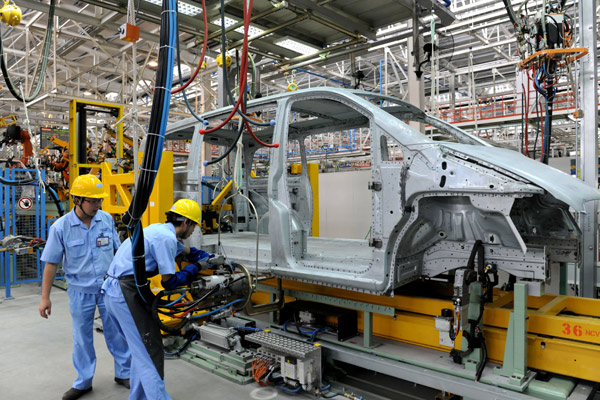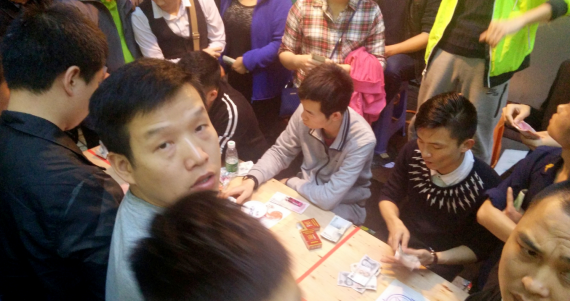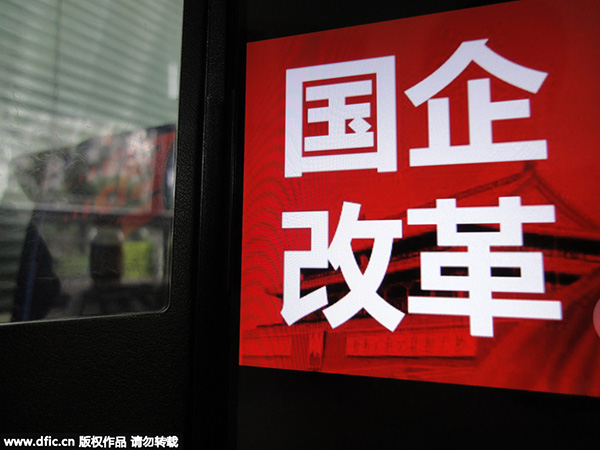–

Â
Why Taiwan has a Largan and China doesn’t

–
No Asian technology company is currently more successful, dominant and more deeply engrained in the daily lives of a billion-plus people worldwide than Largan Precision. While you may not know the name, odds are you carry Largan technology around with you every day.
Largan makes the tiny plastic camera lenses for the high-megapixel cameras built into the iPhone and most higher-end Android devices. Largan enjoys a near-monopoly and is probably the only company in the world supplying an important high-margin component to both Apple and its Android rivals. That means even if Apple’s growth begins to cool, Largan won’t suffer as acutely as other key Apple component suppliers like Silicon Valley favorites Cirrus Logic and InvenSense. Apple may now be more dependent on Largan than Largan is on Apple.
Not that Largan is eager for the world-at-large to know. Though publicly-traded on the Taiwan Stock Exchange, the company is extremely reticent about sharing much information on its robust financial health and its current hammerlock hold on Apple. Largan habitually issues rather gloomy-sounding forecasts, as it did earlier this month, suggesting its growth rate may be slowing. Though its share price has nearly doubled in the last two years, it still trades at an anemic p/e multiple of under 10 times projected 2016 net income.
Smartphone sales are beginning to plateau Also casting a potential shadow, Apple is said to be keen to find an alternative camera lens supplier. The Cupertino company loathes having single-source suppliers like Largan. But, so far it’s proving all but impossible for Apple to find another supplier to match Largan’s price, volume and quality. Patents, Largan has them in abundance. But, its most valuable innovations, the ones Apple and its other customers pay good money for, are mainly unpublished: the sophisticated manufacturing know-how needed to produce in massive quantities at low-cost tiny specs of curved plastic at optical quality.
Fortunes rise and fall quickly in the mobile phone industry. If more proof were needed, just look at Xiaomi, which went from the world’s highest valued to perhaps most overvalued startup in less than a year. Largan, meanwhile, quarter after quarter, remains the envy of the entire Apple and Android manufacturing world.
Cameras — and the quality of photos they take — have never been a more important selling point for mobile handset makers. All the key trends — higher resolution lenses with larger apertures, high-quality cameras front and back, optical zoom and image stabilization — play directly to Largan’s proprietary strengths and know-how. The result, Largan also enjoys about the highest growth rate and market share along with net profit margins among all key mobile component manufacturers.
Despite the slowdown in the growth of mobile phone sales, Largan’s 2015 revenues rose by over 20% to reach $1.7bn, while net income surpassed $700mn. Largan’s +40% net profit margin are double Apple’s.
Few are the public companies anywhere that throw up numbers like Largan’s:

Largan is an example of a company that waited a long time for its moment in the sun. It was started 29 years ago and is still run by its two original founders, Tony Chen and Scott Lin. Both are now dollar billionaires and well past Taiwan’s official retirement age of 65.
I’ve never met the founders, or anyone else from Largan. I’ve learned about the company from the CEOs of some other large Apple and Android suppliers we work with. They uniformly sing Largan’s praises. “Though I try, I can’t find a single weak point except maybe that the founders should probably be retired and working on their golf game” muses one whose Hong Kong-listed company has been trying without success to get into the business selling plastic camera lens to Apple.
If rumors are correct, the next version of the larger iPhone will include dual cameras, front and back, each with much higher megapixel count than the current iPhone6. If so, and Largan as is likely remains the principal supplier, Largan’s revenues and profits from each iPhone sold will increase. Largan already makes similar lenses in bulk for Android brands.
For many years, the company was a small, niche manufacturer, one of dozens in the optics industry clustered around the city of Taichung. Largan’s focus then and now was producing high-quality lenses from plastic rather than glass. Early on plastic lenses seemed more like a novelty, too low in quality to ever seriously compete with the fine glass optical lenses made in Japan for the country’s major camera brands like Nikon, Canon and Minolta.
Largan’s plastic lenses were originally consigned mainly for use inside desktop scanners and projectors. Then the smartphone came along. A decade ago, only half the smartphones sold each year had a built-in camera. Now, it’s nearly 100%. Megapixel count has risen from two to sixteen and sometimes higher. Largan has been at the forefront throughout, but especially over the last five years as specs get higher and customers more demanding. A handset camera needs to take great pictures, but do so without adding much weight, sucking too much battery life or hogging too much space. Glass simply can’t cut it.
Among plastic lens manufacturers, no one else can currently match Largan’s know-how, precision and manufacturing skill. The camera in your mobile phone is a remarkable bit of gear. A typical high-end smartphone camera now has multiple aspherical Largan lenses with different dispersion and refractive properties, stacked about four millimeters high inside a plastic mount. To achieve perfect focus, the lenses need to be perfectly aligned, moveable, have as wide an aperture as possible and optical image stabilization.
Largan makes only lenses. The complete camera module (see photo below of the module from the iPhone) is assembled by other manufacturers, a task that still requires some hand labor and offers tiny margins of 5% or less.

Hon Hai, more commonly known as Foxconn, is one of the companies doing the low-paid module assembly work. Foxconn and Largan are both key Apple suppliers, but sit at opposite ends of the margin spectrum.
Two other things they share in common: both are Taiwanese companies with a large manufacturing presence in China. This underscores an important point about the relative level of technology development in Taiwan and the PRC. Taiwan companies remain light-years ahead in the majority of cases.
Looking just at the Apple ecosystem, while most components as well as finished products are manufactured in China, mainland Chinese companies barely earn a dime from all this. There is no more unbalanced balance-of-trade than the iPhone’s manufacturing and sales in China. Chinese bought around 70 million iPhones last year, with a retail value of over $70bn. But, only a fraction of that stays in China, mainly in the form of sales tax collected by the government from sales in official retail channels and the wages paid to assembly staff at hundreds of factories producing for Apple. The picture isn’t very different with Android phones. What profits there are end up in the hands of high-value non-PRC software and component suppliers, including Largan.
Despite the PRC’s generous subsidies to technology companies and a massive government push to foster indigenous innovation, China’s domestic technology manufacturers remain overwhelmingly stuck producing low-margin commoditized products without any globally significant high-margin IP. True, the PRC got a late start compared to Taiwan. But, there are some other often overlooked systemic factors at work here.
Start with the fact intellectual property remains weakly protected. Mainland Chinese companies have less incentive to do as Largan did and plow years of effort and investment into a new technology with an uncertain path to market.
Seeking risk capital is most often a hopeless quest. The Shanghai and Shenzhen stock exchanges do not allow smaller companies with promising technology and zero profits to go public. China’s domestic venture capital industry most always shuns start-ups working on truly innovative high-tech products, preferring knock-offs of successful US online business models where revenues, if not profits, can be generated more quickly. Longer-term bank lending is all but non-existent.
Another factor that I believe inhibits innovation in China – the country relied on technology transfer, on forcing companies from the developed world to turn over to Chinese joint venture partners some proprietary technology in return for access to the Chinese market. Why innovate at home when foreign companies can be made to hand over trade secrets, albeit outdated ones, for free? This has stunted the growth of a strong foundation of homegrown innovation in China.
China took on low-margin work spurned by earlier generations of Japanese, Korean and Taiwanese manufacturers. But, Chinese companies have so far mainly failed to build something more substantial on top of this by adding their own proprietary improvements that can command higher prices. Margins, always threadbare, are instead vaporizing across the domestic manufacturing sector due to rising wages, benefits, environmental compliance and energy costs as well as taxes.
Then look at Largan. Its margins, despite weak overall mobile phone growth, are on track to actually increase this year above already stellar levels. As good as the camera on your mobile is, there is enormous scope for the hardware to get better, smaller, lighter, faster, flatter. It’s hard to envisage anyone else pushing the process more propulsively and successfully than Largan.
Download our Chinese-language article on Largan as published in Caijing Magazine
As published in Nikkei Asian Review
Download PDF version.
–
































